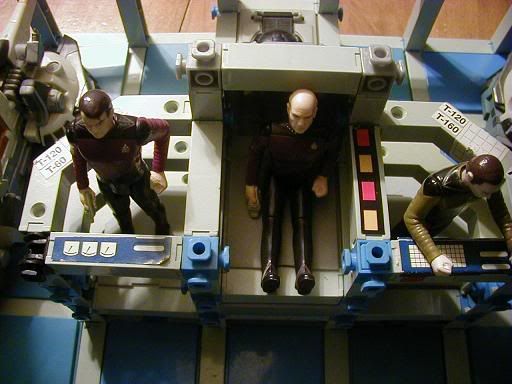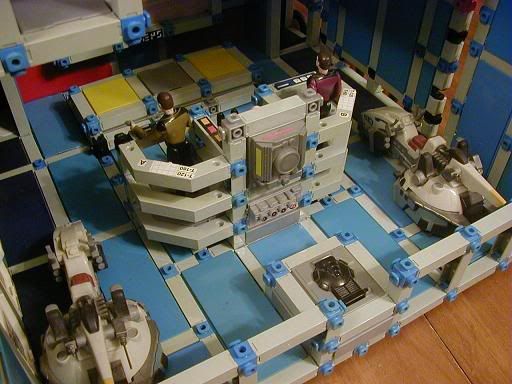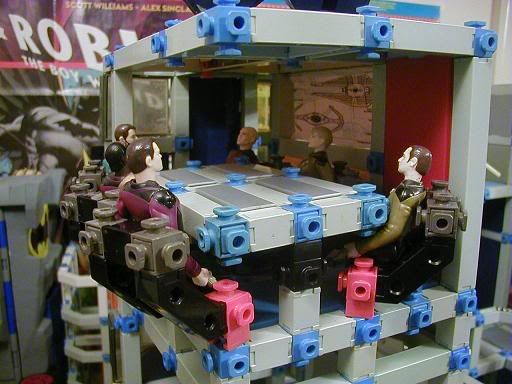The A207 and I had some history. I built its first incarnation sometime in 1993 (at the age of 13). Gradually, over time, I added on and changed everything that I could, constantly seeking to make it better as it, in turn, made me a more creative builder. A few years later, I took it apart and put all of my toys away (for good, I thought). Finally, in 2000, I resurrected the A207, building it again from scratch (and memory) in a better, more improved form. I didn't think I could do it, but I did...and it felt great.
So there I was the other day, looking through the old photos on the website, disliking my new Secret Loft Headquarters design, and longing for the old A207. It was time for another resurrection. Eight years after its last major overhaul, the A207 is back in a new form, as a result. Benefiting from seven years and nine new playsets worth of experience, this re-envisioned mobile command fortress is simpler where I felt it needed to be simpler, more complex where I felt it needed to be more complex, and definitely more play friendly. I think I'm proudest of having found a way to open up some of the previously hard to access areas without sacrificing appearance at all. Overall, I think the inside looks a lot cleaner and more play friendly as well. The last incarnation was built by a kid who kept adding on new things whenever he got bored, leading to lots of clutter. This new A208 was built by a somewhat wiser and more grown up kid who has a better appreciation for balance.
So, is this the last incarnation of the Mobile Command Fortress?
No, I seriously doubt it...
The exterior of the A208. It is remarkably similar to the A207, but I have added a new "nose" to the A208 that I rather like. The lower canopy on the nose can actually be opened and connects to a small hatch in main engineering through which missiles and probes could probably be launched. The gunner stations on the towers look a bit different on the A208 too. I've given them more versatile joints made up of three separate pivots, allowing them a far greater range of motion while being able to remain stationary without falling over. Additionally, the roof on the A208 is shorter to allow more light and open space on the interior. This means that, instead of docking a fighter jet there, I only had space for a high-tech looking mining/defense laser, which is set on the same three joint pivot system. The fighter jet has been replaced with two air bike interceptors stored inside.
The interior from a distance.
The command level. I'm really pleased with the changes I made here. I felt this level really suffered in earlier incarnations, particularly since I didn't have enough panels to finish the look of the walls correctly in the old version.
You'll notice the addition of two elevator shafts to the sides of this level. While these shafts don't actually work, I prefer their look to the clumsy ladders used on the A207. I'd imagine the engineers who built this thing had time to improve upon the old model, creating more comfort for a crew that would be cooped up inside for long missions.

Reverse angle view of the captain's chair.

There is now a transporter pad in front of the command chair. I really like the step up in front of it. Somehow, that makes it look more realistic.

I have also added an energy chamber behind the command chair (for dilithium crystals?). While I like the addition of both this and the transporter pad a great deal, they were primarily included to conceal additional sets of wheels beneath them. This keeps the fortress from sagging under its own weight, a problem I experienced with the A207. The command chair has wheels beneath it too. The floor is additionally reinforced with metal rods.
Two airbikes (from the long forgotten Xyber9 series) are now stationed behind the command chair. I actually had these stations included in the old A207 but, at the time of including it on this site, I was in a small apartment and needed to shave a few inches off the back of the A207 in order to keep it out of the way. Now there's room for air bikes again.
The engineering level in new, more pleasing colors. I think it looks very Star Trek: Next Generation, which is probably why I've used those figures to model it.
The addition of the elevator shafts aside, the only big change on this level is that I've moved the main engine to the far wall, leaving more space for the engineers. I really wanted to give the impression that technology had improved somewhat between the building of the A207 and A208. So, while the A207 was full of clumsy, experimental looking technology, the A208 looks more refined and comfortable with these technologies. The location of the main engine is intended to reflect this.
Captain Picard takes the elevator (or turbolift, if you must) to the engineering level.
Were he to go through that door from the last photo, he would see this empty room. It is reserved for guests and/or cargo, sporting three bunks on the rear wall and a lot of empty space. This more advanced mobile command fortress, with more efficient stations and more sophisticated automatic systems, requires a smaller crew to man it than the A207. This allows them to free up an entire room for transport, guests, and even small groups of displaced refugees.
I've always tended to imagine the A207/A208 as existing in a post-apocalyptic world where the surviving civilization would send out a giant mobile fortress to search for survivors and offer aid. Now the A208 finally has the space to accomplish such a mission, bringing supplies and even transporting survivors.
Here's the identical room on the other side of the fortress. This is where the crew takes turns off duty. I've included a couch that fits up to two people. Three bunks are on the far wall.
I really like how removing a wall has opened up the space in these rooms. On the A207, the rooms were always dark and difficult to play in.
The third floor briefing room (in the left wing of the fortress). This looks a billion times better than the old captain's quarters.
Picard grabs the elevator outside of the briefing room.
The new captain's quarters.
Finally, here's the new main door for the fortress, located on the first floor, right wall.
It's far bigger than the old door (allowing the air bikes to deploy) and even has ramps attached, allowing more comfortable access to the ground.
Modification 4/05/09: Wing Rooms
I've spent some time revamping the smaller side rooms in order to give them more of a Next Generation feeling.

The top left wing has been converted into a briefing room that comes somewhat closer to resembling the Next Generation version. The table and chairs take up so much space that the chairs on the left side are actually leaning over the edge of the playset. They added so much weight to the room that I had to reinforce the floor under it.

The top right wing has been converted from a Captain's Quarters to something resembling Picard's Ready Room. While this should probably be closer to the Bridge, this was where I had room for it. It's a more exciting space than Picard's personal quarters.

The right wing generic crew's quarters has marginally changed to include a table and a slimmer chair. It just looks a little more comfortable.

And that random storage space on the left side has been turned into a second crew's quarters because I was tired of looking at empty space.

As a final minor addition, I've added warp nacelles to the rear of the fortress. They really don't make any sense there, but they look cool.